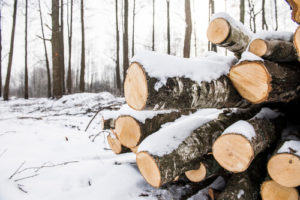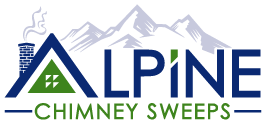It’s funny how a fall breeze feels different than a spring breeze. There’s just a touch of chill in the air, advanced notice of the cold winds that will soon blow through the state, bringing with them snow, ice, and many great opportunities to curl up in front of a crackling fire. Is your fireplace and chimney system ready for the increased wear and tear that those snowy days will bring? If not, now is the time to prepare, before you get caught in the house with nothing to do but relax in front of the fireplace!
Firewood
One of the first things you should be thinking about is loading up on firewood. That may seem like a simple plan; just head outside and cut up a tree, right? Actually, it’s important to put some thought into the type of wood you burn. First, if you’re purchasing firewood, make sure that it’s been cured properly. There are several ways to determine if this is the case. Well cured wood will be lighter in both color and weight than uncured wood. The bark becomes more loosely attached as wood dries, and it also loses that sharp sap smell. Clap two pieces of wood together. Cured wood sounds more hollow, with less of a thunk sound, than uncured wood.
It’s important to burn only cured wood, or you may end up with a smoky fire that will create more creosote buildup in your chimney. And speaking of creosote buildup, another important thing to do to prepare for winter is to have your chimney inspected and cleaned before using it.
Inspection and Sweeping
One of the most important things that a chimney sweep will be looking for when inspecting your chimney is the presence of creosote. When you use your fireplace, the water vapor that is released in the form of smoke carries with it many different chemicals, some of which can be harmful to your health. Included in these are carbon monoxide, methane, benzene, aldahydes, and nitrogen oxides. While some of that smoke is directed out of your home through the chimney, a portion gets stuck to the sides of your chimney as the water vapor condenses onto the cooler interior surface near the top of the chimney. This condensed product is creosote, and it is extremely flammable. That’s why it’s important to have an experienced group of professionals like those at Alpine Chimney Sweeps inspecting and sweeping your chimney. We’ll dig in and get rid of the creosote buildup you have in your chimney, and that will allow you to rest easy knowing that the risk of a chimney fire is gone as well.
Clean Out the Firebox
Another thing you’ll want to do is clean out your firebox if you haven’t already done so. Shovel the loose ashes into a bag and take the bag outdoors to dispose of it. You can vacuum any leftover ashes. Use a stiff bristled brush to brush down the sides to get rid of any soot or dirt and vacuum that up as well.
Taking these steps now will ensure that you can enjoy your fireplace safely and comfortably all winter long!

Recent Comments